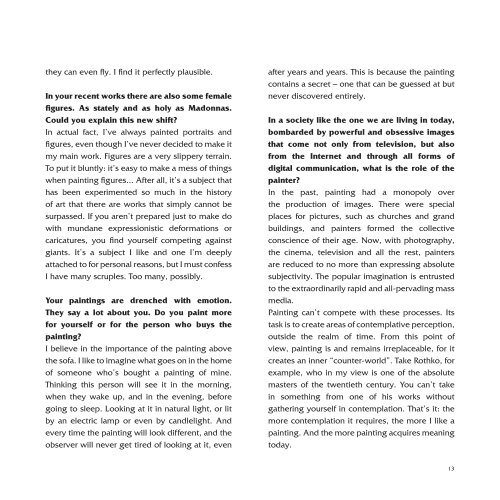Catalogo download - Matthias Brandes
Catalogo download - Matthias Brandes
Catalogo download - Matthias Brandes
You also want an ePaper? Increase the reach of your titles
YUMPU automatically turns print PDFs into web optimized ePapers that Google loves.
they can even fl y. I fi nd it perfectly plausible.<br />
In your recent works there are also some female<br />
fi gures. As stately and as holy as Madonnas.<br />
Could you explain this new shift?<br />
In actual fact, I’ve always painted portraits and<br />
fi gures, even though I’ve never decided to make it<br />
my main work. Figures are a very slippery terrain.<br />
To put it bluntly: it’s easy to make a mess of things<br />
when painting fi gures... After all, it’s a subject that<br />
has been experimented so much in the history<br />
of art that there are works that simply cannot be<br />
surpassed. If you aren’t prepared just to make do<br />
with mundane expressionistic deformations or<br />
caricatures, you fi nd yourself competing against<br />
giants. It’s a subject I like and one I’m deeply<br />
attached to for personal reasons, but I must confess<br />
I have many scruples. Too many, possibly.<br />
Your paintings are drenched with emotion.<br />
They say a lot about you. Do you paint more<br />
for yourself or for the person who buys the<br />
painting?<br />
I believe in the importance of the painting above<br />
the sofa. I like to imagine what goes on in the home<br />
of someone who’s bought a painting of mine.<br />
Thinking this person will see it in the morning,<br />
when they wake up, and in the evening, before<br />
going to sleep. Looking at it in natural light, or lit<br />
by an electric lamp or even by candlelight. And<br />
every time the painting will look different, and the<br />
observer will never get tired of looking at it, even<br />
after years and years. This is because the painting<br />
contains a secret – one that can be guessed at but<br />
never discovered entirely.<br />
In a society like the one we are living in today,<br />
bombarded by powerful and obsessive images<br />
that come not only from television, but also<br />
from the Internet and through all forms of<br />
digital communication, what is the role of the<br />
painter?<br />
In the past, painting had a monopoly over<br />
the production of images. There were special<br />
places for pictures, such as churches and grand<br />
buildings, and painters formed the collective<br />
conscience of their age. Now, with photography,<br />
the cinema, television and all the rest, painters<br />
are reduced to no more than expressing absolute<br />
subjectivity. The popular imagination is entrusted<br />
to the extraordinarily rapid and all-pervading mass<br />
media.<br />
Painting can’t compete with these processes. Its<br />
task is to create areas of contemplative perception,<br />
outside the realm of time. From this point of<br />
view, painting is and remains irreplaceable, for it<br />
creates an inner “counter-world”. Take Rothko, for<br />
example, who in my view is one of the absolute<br />
masters of the twentieth century. You can’t take<br />
in something from one of his works without<br />
gathering yourself in contemplation. That’s it: the<br />
more contemplation it requires, the more I like a<br />
painting. And the more painting acquires meaning<br />
today.<br />
13


